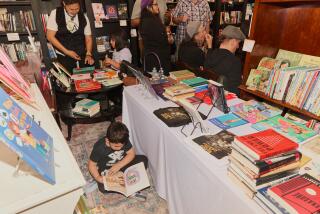Ward Ritchie; Master Printer, Bibliophile
- Share via
Ward Ritchie, prolific and world-renowned printer, book collector, writer and historian of the book arts, who wrote nearly 100 books, designed about 750, published thousands, and spent his retirement years meticulously printing more than two dozen volumes on an 1835 Albion hand press, has died. He was 91.
One of the last of the fine printers who flourished in Southern California in the 1920s and 1930s, Ritchie died Wednesday night at his Emerald Bay home in Laguna Beach of pancreatic cancer, it was announced Friday.
The era’s dwindling cadre of printers, publishers and booksellers, bibliophiles all, used fine paper, hand-set lead type and hand-fed printing presses to create enduring works of art and scholarship and give Southern California a special niche in world literature.
“My generation learned how to set type, how to design a page, how to run a press. Now it takes a computer expert to set type, and book design is being done by professional designers,” he told The Times about printing technology that has changed radically in recent years.
All printers print, but Ritchie did more. He immortalized the history and beauty of printing by writing about it eloquently.
“Ward Ritchie is a marvelous writer and raconteur, especially of the history of fine printing and book making as a Los Angeles tradition. . . . He opens the door to the past and invites us to step inside with him,” Thomas F. Andrews, executive director of the Historical Society of Southern California, said in a tribute for Ritchie’s 90th birthday last year.
Among Ritchie’s writings were books about his own printing, including the 1961 “The Ward Ritchie Press,” describing the publishing firm he ran from 1932 to 1974 that specialized in Western Americana and cooking, “A Concise Account of Ward Ritchie, His Printing & His Books, Written by Himself” in 1984, and a later account of his Laguna Verde Imprenta, the hand-press publishing company he operated in his retirement home.
In his youth, Ritchie wrote under a variety of pseudonyms--Davie Dicker, James Beattie Pittwood, Betsey Ann Brestol, Peter Lum Quince--but after 50 years he confessed to all of them, in print.
Over his long career, Ritchie printed a variety of books, ranging from catalogs of the holdings of collector Estelle Doheny, to his largest, a 720-page history of the Transpac race, to his smallest, a 37-word book by a judge’s 7-year-old daughter. Titled “The Pig,” the total book read: “Once upon a time, a pig named Snoot got tired of life in a pen, so he decided to run away. But where would the little pig run to? So he thought he would stay at home.”
Born to a Pasadena family, Ritchie began publishing while a student at Marengo Avenue School, producing the one-page “Marengo Literary Leader,” which offered advertisements for 25 cents and included an article called “The Purple Dragon” by lifelong friend and future UCLA Head Librarian Lawrence Clark Powell.
Ritchie studied art, literature and poetry at the University of the South, Stanford and finally Occidental College, where he graduated. He studied law for one semester at USC, but decided he would rather do “something creative”--print books.
“I didn’t think I could write the Great American Novel,” he told The Times in 1976, “and I didn’t think I could paint as well as Matisse or Picasso--but I thought I could combine these two ambitions in printing.”
Ritchie got a job at Vroman’s bookstore in Pasadena, read every book on fine printing he could find, and enrolled in a vocational printing course at Frank Wiggins Trade School, the forerunner of Los Angeles Trade Tech. He also went to France and talked his way into a year’s apprenticeship with Francois-Louis Schmied, a Parisian master printer.
With Powell, Ritchie rented a printing studio and wrote to poets Carl Sandburg, Archibald MacLeish and Robinson Jeffers, seeking material to print. Amazingly, they sent poems.
Ritchie succeeded early in life, he later reflected, because he was “stupid enough not to be frightened. Anybody with any intelligence would know you’re supposed to start at the bottom and work your way up. I started at the top.”
He had little trouble staying there, detouring from his fine printing only during World War II, when he printed aircraft training manuals for Douglas.
Scornful of any perceived “Ward Ritchie style,” the printer prided himself on designing each book to fit its subject matter.
“The main object of a trade book is to make the reader want to read it,” he once said. “You try to put warmth into the design so the reader will pick it up, get into the subject and keep going.”
Powell, in notes for a 1983 museum exhibit of Ritchie’s work, praised his old friend for the “sure grace with which he moved from book to book, almost never repeating himself and always suiting the design to the purpose . . . never ignoring the book’s basic function to be read and not only looked at as a work of art.”
Always a collector, Ritchie considered himself among the less moneyed of the known bibliophiles and too poor to be a part of the fabled Zamorano Club when it was formed in 1928. So he started his own collector organization called the Rounce & Coffin Club. In 1934, he was welcomed into the elite group named for Agustin V. Zamorano, who brought the first printing press to California, and was an active member and speaker for six decades.
He pared his personal collection of books from 8,000 volumes to about 3,500 when he moved to Laguna Beach in 1974, donating the others to the Huntington Library and to libraries at Occidental College, UCLA and Scripps College.
His beloved Ward Ritchie Press, which altered its name in later years, ceased to exist a few years after Ritchie sold it in 1974.
Once divorced and once widowed, Ritchie was the father of five sons. In recent years, his frequent companion was lifelong friend Gloria Stuart, the actress and artist.
More to Read
Sign up for our Book Club newsletter
Get the latest news, events and more from the Los Angeles Times Book Club, and help us get L.A. reading and talking.
You may occasionally receive promotional content from the Los Angeles Times.






